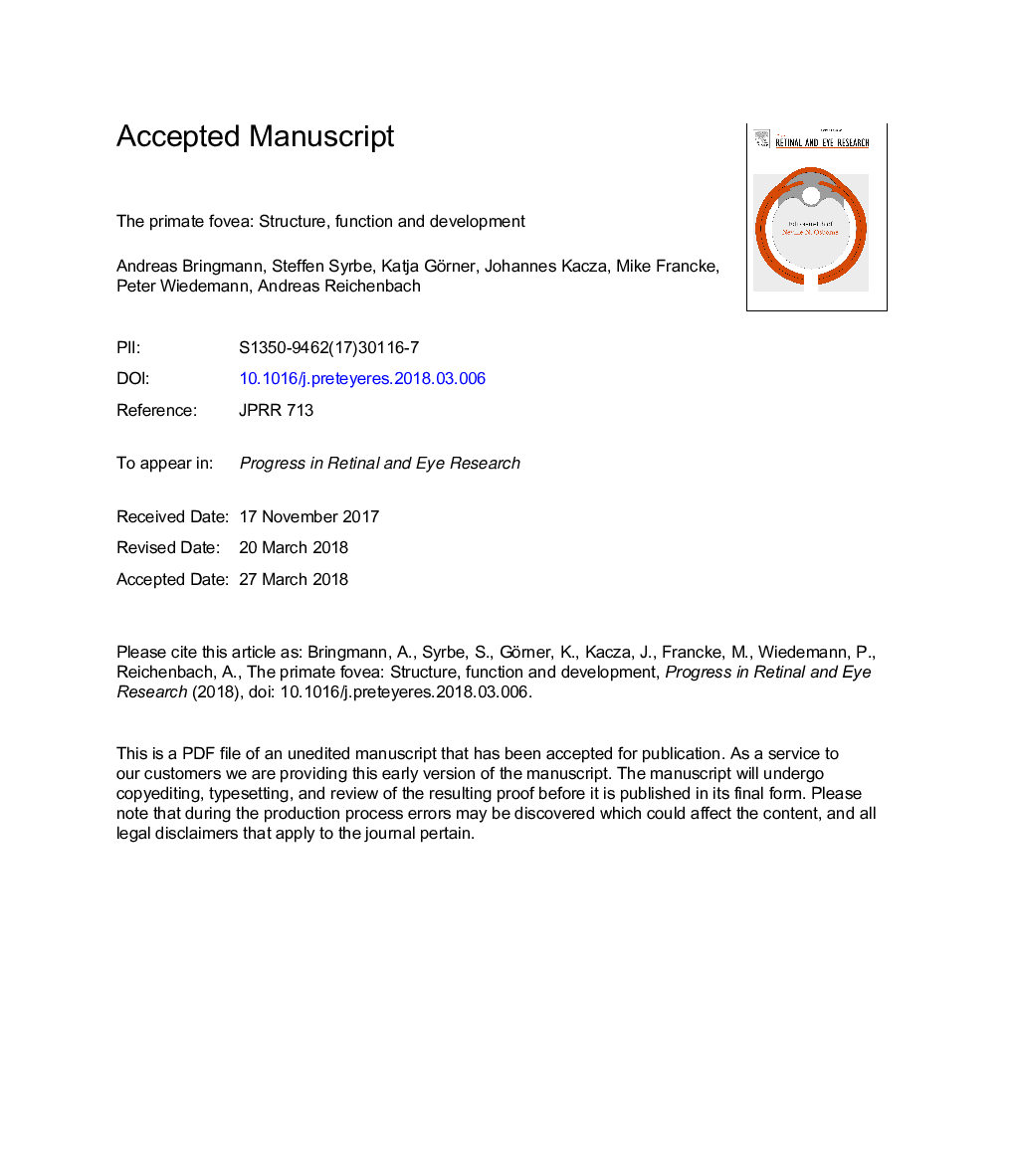| کد مقاله | کد نشریه | سال انتشار | مقاله انگلیسی | نسخه تمام متن |
|---|---|---|---|---|
| 10220984 | 1697527 | 2018 | 88 صفحه PDF | دانلود رایگان |
عنوان انگلیسی مقاله ISI
The primate fovea: Structure, function and development
ترجمه فارسی عنوان
فتوای پریمات: ساختار، عملکرد و توسعه
دانلود مقاله + سفارش ترجمه
دانلود مقاله ISI انگلیسی
رایگان برای ایرانیان
کلمات کلیدی
ONLHFLHenle fiber layerRFLOLMNFLPDGFOPLBclILMINLIPLGFAPGCLRPEFGFAstrocyte - آستروسیتretinal pigment epithelium - اپیتلیوم رنگدانه شبکیهOct - اکتبرOptical coherence tomography - توموگرافی انسجام نوریACL - رباط صلیبی جلوییMüller cell - سلول مولرouter limiting membrane - غشای محدود کننده خارجیinner limiting membrane - غشای محدود کننده درونیVascular endothelial growth factor - فاکتور رشد اندوتلیال عروقیVascular Endothelial Growth Factor (VEGF) - فاکتور رشد اندوتلیال عروقی (VEGF)platelet-derived growth factor - فاکتور رشد حاصل از پلاکتfibroblast growth factor - فاکتور رشد فیبروبلاستFovea - فوواouter plexiform layer - لایه بیرونی بیرونیouter nuclear layer - لایه بیرونی هسته ایinner plexiform layer - لایه داخلی لایهinner nuclear layer - لایه داخلی هسته ایganglion cell layer - لایه سلول گانگلیونیNerve fiber layer - لایه فیبر عصبیPrimate - نخستیسانان، نخستیها، پریمات هاOptics - نورشناسی، اپتیکGlial fibrillary acidic protein - پروتئین اسیدی فیبریلاسیون گلایالGlia - یاختههای گلیال
موضوعات مرتبط
علوم زیستی و بیوفناوری
علم عصب شناسی
سیستم های حسی
چکیده انگلیسی
A fovea is a pitted invagination in the inner retinal tissue (fovea interna) that overlies an area of photoreceptors specialized for high acuity vision (fovea externa). Although the shape of the vertebrate fovea varies considerably among the species, there are two basic types. The retina of many predatory fish, reptilians, and birds possess one (or two) convexiclivate fovea(s), while the retina of higher primates contains a concaviclivate fovea. By refraction of the incoming light, the convexiclivate fovea may function as image enlarger, focus indicator, and movement detector. By centrifugal displacement of the inner retinal layers, which increases the transparency of the central foveal tissue (the foveola), the primate fovea interna improves the quality of the image received by the central photoreceptors. In this review, we summarize â with the focus on Müller cells of the human and macaque fovea â data regarding the structure of the primate fovea, discuss various aspects of the optical function of the fovea, and propose a model of foveal development. The “Müller cell cone” of the foveola comprises specialized Müller cells which do not support neuronal activity but may serve optical and structural functions. In addition to the “Müller cell cone”, structural stabilization of the foveal morphology may be provided by the 'z-shaped' Müller cells of the fovea walls, via exerting tractional forces onto Henle fibers. The spatial distribution of glial fibrillary acidic protein may suggest that the foveola and the Henle fiber layer are subjects to mechanical stress. During development, the foveal pit is proposed to be formed by a vertical contraction of the centralmost Müller cells. After widening of the foveal pit likely mediated by retracting astrocytes, Henle fibers are formed by horizontal contraction of Müller cell processes in the outer plexiform layer and the centripetal displacement of photoreceptors. A better understanding of the molecular, cellular, and mechanical factors involved in the developmental morphogenesis and the structural stabilization of the fovea may help to explain the (patho-) genesis of foveal hypoplasia and macular holes.
ناشر
Database: Elsevier - ScienceDirect (ساینس دایرکت)
Journal: Progress in Retinal and Eye Research - Volume 66, September 2018, Pages 49-84
Journal: Progress in Retinal and Eye Research - Volume 66, September 2018, Pages 49-84
نویسندگان
Andreas Bringmann, Steffen Syrbe, Katja Görner, Johannes Kacza, Mike Francke, Peter Wiedemann, Andreas Reichenbach,
